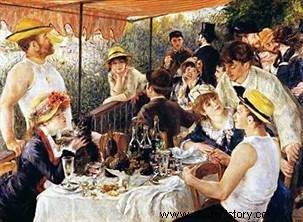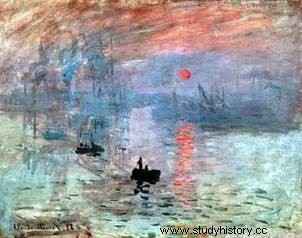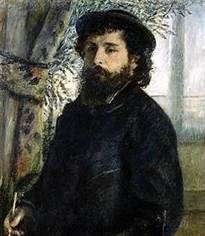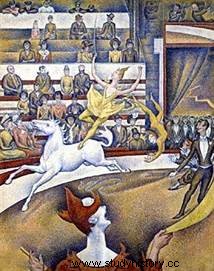 In painting, Impressionism is an artistic movement that appeared in France in the 1860s. This term refers to the famous painting by MonetImpression, rising sun (1872), and also designates a style of music that appeared at the end of the 19th century. The Impressionists paint outdoor scenes by revealing the effect produced by the constant and imperceptible variations of light on the elements, such as the shimmering of the waters. Claude Monet, Paul Cézanne, Pierre-Auguste Renoir, Alfred Sisley, as well as Camille Pissarro are the main representatives of the movement. At first criticized and misunderstood, they were excluded from official salons and organized their own exhibition in 1874 in Paris.
In painting, Impressionism is an artistic movement that appeared in France in the 1860s. This term refers to the famous painting by MonetImpression, rising sun (1872), and also designates a style of music that appeared at the end of the 19th century. The Impressionists paint outdoor scenes by revealing the effect produced by the constant and imperceptible variations of light on the elements, such as the shimmering of the waters. Claude Monet, Paul Cézanne, Pierre-Auguste Renoir, Alfred Sisley, as well as Camille Pissarro are the main representatives of the movement. At first criticized and misunderstood, they were excluded from official salons and organized their own exhibition in 1874 in Paris.
A new artistic approach
The Impressionist movement was born in France in the 1860s, with a new generation of artists who admired the art of Camille Corot (1796-1875), a pioneer of outdoor painting. The first painter to break with tradition, Corot aimed for a realistic and luminous representation of nature. He inspired the creation of groups in Fontainebleau, Honfleur, Provence and the Lyonnais. From 1865, the painter Charles François Daubigny (1817-1878) appears as head of the school of printing. With Antoine Chintreuil (1814-1873), he traveled the Oise by boat.
Another precursor, Eugène Boudin (1824-1898), played an important role in Monet's career. Fascinated by the inconstancy of the colors of nature, which change according to the time of day and the wind, he recommends that the young artist paint outdoors. Between 1857 and 1861, the greatest representatives of the Impressionist movement, from different backgrounds, met in the studio of Professor Charles Gleyre (Monet, Renoir), at the Swiss Academy (Monet, Pissarro, Cézanne) or at the Louvre (Degas, Manet). They advocate a less radical realism than that of Gustave Courbet. To make themselves known, they must impose themselves at the Salon, where the jury pays little attention to landscapes. Édouard Manet caused a scandal there in 1865 with Olympia.
The method and the term "Impressionism"
 The execution of the impressionist painting is quite fast; it's about transcribing a fleeting impression. They abandon drawing with precise contours, chiaroscuro and suggest the shapes, volumes and atmosphere of the moment with small touches of primary and complementary colors. The tones are broken down:a green tone, for example, is obtained by juxtaposing a touch of blue and a touch of yellow. Impressionist paintings are characterized by the colorful burst of paint strokes that form a realistic whole. The history of this current is traditionally linked to the exhibition of paintings by Monet, Renoir and Cézanne, but in truth, it goes beyond this framework fixed between 1874 and 1886.
The execution of the impressionist painting is quite fast; it's about transcribing a fleeting impression. They abandon drawing with precise contours, chiaroscuro and suggest the shapes, volumes and atmosphere of the moment with small touches of primary and complementary colors. The tones are broken down:a green tone, for example, is obtained by juxtaposing a touch of blue and a touch of yellow. Impressionist paintings are characterized by the colorful burst of paint strokes that form a realistic whole. The history of this current is traditionally linked to the exhibition of paintings by Monet, Renoir and Cézanne, but in truth, it goes beyond this framework fixed between 1874 and 1886.
Monet finishes his painting Impression, rising sun in 1873. Exhibited the following year, it was the subject of a negative assessment by Louis Leroy in Le Charivari, a controversial daily newspaper. The critic uses the term impressionism for the first time. He wants to be dismissive, but Monet does not let himself be discouraged. In 1877, he used the term twice, on the occasion of the 1877 exhibition and during the baptism of the review L'Impressionniste, journal d'art. This name ultimately contributes to the glory of the movement. It designates the new generation of artists in search of light and who paint by successive strokes.
In addition to nature and its landscapes, the city and its modernity, scenes of life were also the subjects of the Impressionists, who sought to capture both the hectic bustle of the city and its particular light. Thus, Claude Monet painted a series of canvases representing the Gare Saint-Lazare, Edgar Degas shows the lively world of racetracks, the Opera, cafes, and Pierre-Auguste Renoir painted the Moulin de la Galette.
Claude Monet and Pierre Auguste Renoir
In the beginning, Monet copied more than he innovated. It imitates without freshness the melancholy representation of its predecessors. From 1863, he trained his peers, including Renoir, to work in the forest of Fontainebleau. From 1866, he showed greater originality and produced several masterpieces (La Terrasse au bord de la mer near Le Havre, 1866, and Les Femmes au jardin, 1867 ).
 The landscape is no longer representative of the painter's state of mind. It becomes the pretext for purely formal work. Monet paints only the brilliance of nature. He makes color the real subject of his paintings and reproduces the impression that an elusive landscape gives him. He achieves such mastery of the effect that the wind and the light become almost palpable. He manifests an unprecedented freedom in the history of Western painting with regard to academic subjects and forms. His art culminates in the depiction of Nymphs, inspired by his garden in Giverny from the 1890s.
The landscape is no longer representative of the painter's state of mind. It becomes the pretext for purely formal work. Monet paints only the brilliance of nature. He makes color the real subject of his paintings and reproduces the impression that an elusive landscape gives him. He achieves such mastery of the effect that the wind and the light become almost palpable. He manifests an unprecedented freedom in the history of Western painting with regard to academic subjects and forms. His art culminates in the depiction of Nymphs, inspired by his garden in Giverny from the 1890s.
While Renoir excelled in the reproduction of landscapes, he favored the representation of characters. Quickly tempted by success, he presented his paintings at the Salon. Rejected several times, he was accepted in 1868 with Lise à l’ombrelle . He shows a taste for the play of light and shadow, visible in his other works from the Impressionist period. In 1874, he participated in the first exhibition of the Impressionists. He then produced Rising Path in the Tall Grass (1875) , The Moulin de la Galette (1876 ), Mme Charpentier and her children (1878) and The Luncheon of the Boating Party (1881) . Subsequently, it moves away from the movement.
Post-Impressionism and influence in music
Post-Impressionism refers to several styles of painting that continue Impressionism or break with it. Vincent Van Gogh and Henri de Toulouse-Lautrec refer to their early days as Impressionists, before opening up new pictorial paths. Neo-Impressionism is represented by Georges Seurat (A Sunday on La Grande Jatte), Camille Pissarro and Paul Signac. These painters use a particular technique, pointillism, which consists of applying tiny dots of pure colors to the canvas. Seen with a certain distance, these assembled keys constitute forms, zones of shade and light.
In the field of music, impressionism will flourish especially in France, from the end of the 19th century to the beginning of the 20th century, under the influence of impressionist painting and the poetry of Paul Verlaine, Charles Baudelaire and Stéphane Mallarme. It contrasts with the classical style (Mozart, Beethoven) which places great emphasis on forms (sonata, symphony), but also with romantic music and its exuberant sensitivity.
The composer Claude Debussy is the main representative of Impressionism through his sonic refinement and his very rich harmonic palette of colors. His main works are titled Prelude to the Afternoon of a Faun and Pelléas et Mélisande.
The Legacy of the Impressionists
 Each Impressionist painter exhibits a touch of originality. With the exception of Monet, their art evolved towards new aesthetic research. Thus, Renoir abandoned painting in strokes and drew more precise contours. Cézanne begins to represent compact forms structured by light. But the impressionist approach upset all academicism.
Each Impressionist painter exhibits a touch of originality. With the exception of Monet, their art evolved towards new aesthetic research. Thus, Renoir abandoned painting in strokes and drew more precise contours. Cézanne begins to represent compact forms structured by light. But the impressionist approach upset all academicism.
In addition, these painters who want to be realistic break down reality, they make it fleeting by trying to detect what is elusive in nature. They prefigure the pointillist or neo-impressionist current illustrated by Georges Seurat (1859-1891). Impressionist art remains figurative, but it announces the abstraction of the 20th century because it privileges color to the detriment of content. Vincent Van Gogh and Henri de Toulouse-Lautrec also claim to belong to Impressionism in their early days, before opening up new pictorial paths.
To go further
- The true story of the Impressionists, by Xavier Mauduit and Cédric Lemagnent. Armand Colin, 2017.
- Little Encyclopedia of Impressionism, by Gabriele Crepaldi. Solar, 2018.
